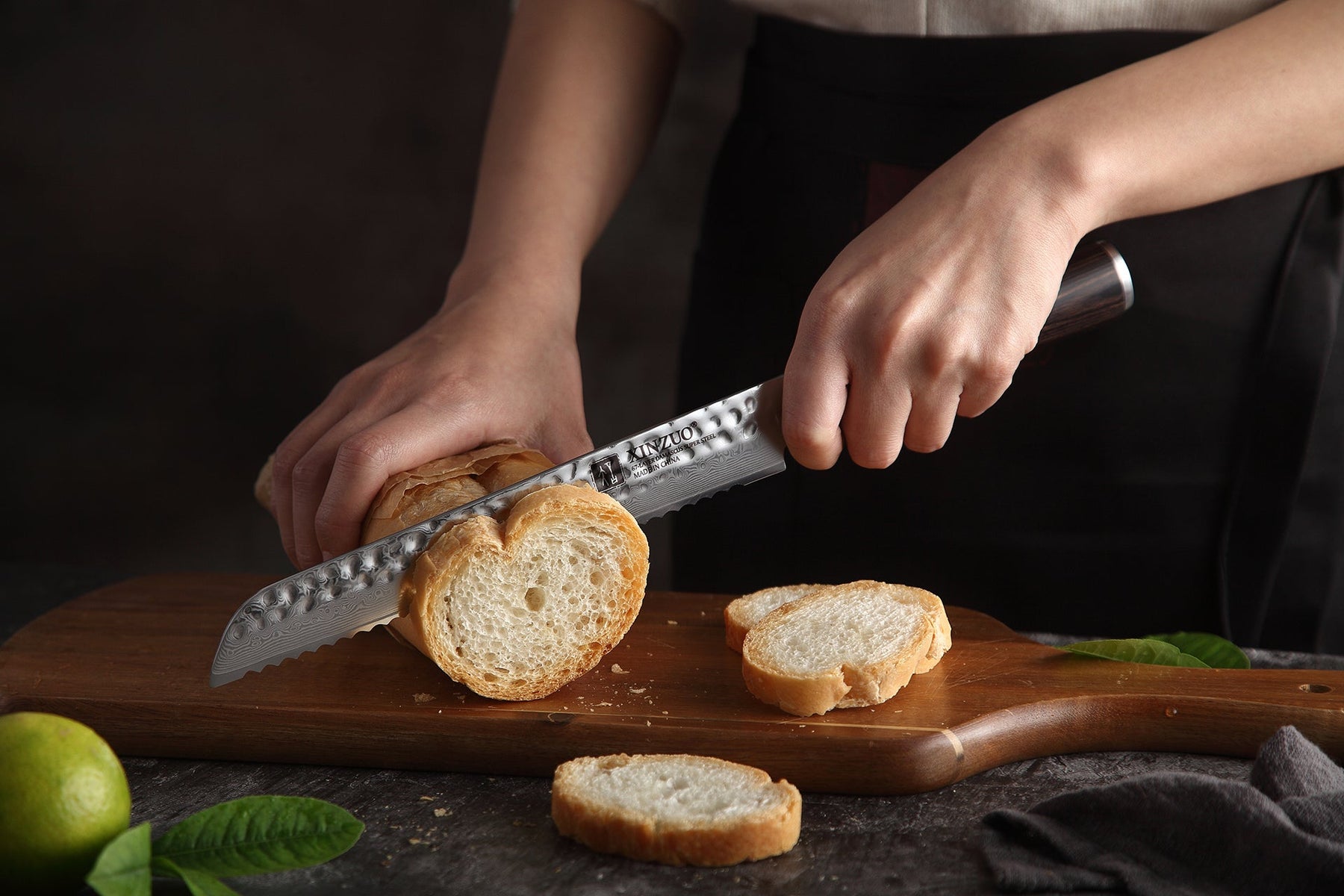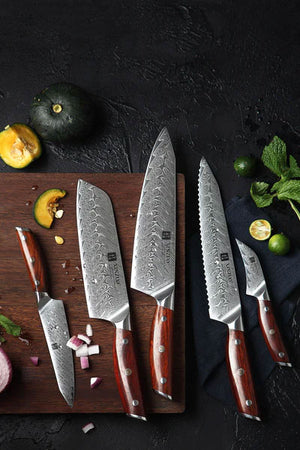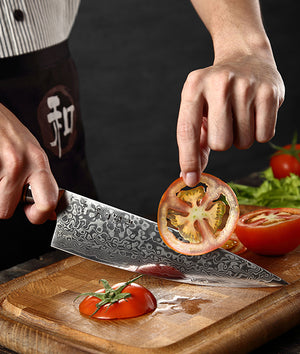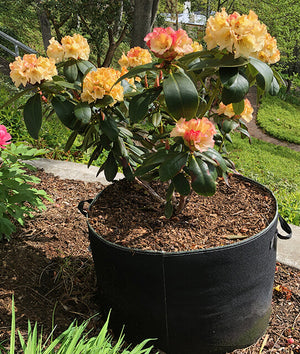
Why Are Serrated Knives Used In the Kitchen?
There are a few essential tools that every kitchen absolutely has to have - a chef’s knife, a cutting board, maybe a paring knife - and if you’re lucky, a great serrated knife.
While they’re often overlooked in favor of their sleek, straight-edged counterparts, serrated knives are incredibly useful, especially for certain types of cutting tasks - and not only for bread, as many people erroneously believe. Although if you've ever tried to slice through a crusty loaf of bread with a regular knife, you already know the struggle. That’s where serrated knives come in.
So, what exactly is a serrated knife? What makes it different from other knives, and when should you be reaching for it? Stick around while we break it down for you.
What Can a Serrated Knife Do?
As we said, serrated knives don’t exist for the sole purpose of cutting bread (although there would be nothing wrong with that).
Serrated knives actually have far more utility than many realise - they’re able to do much more. Their unique edge design makes them incredibly versatile for a range of kitchen tasks.
Here are a few things serrated knives are particularly good at:
1. Cutting Bread and Baked Goods
Starting off with the obvious, crusty loaves, bagels, cakes, and pastries benefit from a serrated knife’s gentle, sawing action. Instead of squishing or tearing, the blade moves cleanly through tough crusts and delicate crumbs alike, because let’s be honest, the last thing anyone wants to do to a freshly baked loaf of bread or a beautiful slice of cake is squash it.
2. Slicing Tomatoes and Other Soft Fruits
Tomatoes, peaches, and even citrus fruits have soft, juicy interiors wrapped in a thin, sometimes tough skin. If you try to cut these things with a standard, straight-edged blade, you’re probably going to struggle to penetrate the skin without applying too much force. And if you use too much muscle, you’re probably just going to squash it. Thus, a serrated knife makes quick work of it with minimal pressure.
3. Cutting through Tough Skins
Melons, pineapples, and even some winter squashes can be surprisingly tough, and if you use the wrong knife, not only are you going to struggle, but you also run the risk of slipping and cutting yourself. A serrated blade can grip the exterior and help initiate the cut more easily than a smooth blade.
4. Carving Meats
Although not all meat should be sliced with a serrated knife, certain cuts like roasts with a crust or barbecue with bark (the crispy exterior) benefit from the sawing action of a serrated edge. A serrated knife is great for rougher-looking meat cuts rather than precise slices.
5. General Utility Work
Some people keep a serrated utility knife around for opening packaging, slicing sandwiches, or even cutting cooked pizza. While not every task demands a serrated blade, it's often the right tool when texture is involved, which is actually way more often than you think.
When Should Serrated Knives Be Used?
The key to choosing a serrated knife is understanding the texture of the item you're cutting - it’s ot just about taking a big old bread knife and hacking away (although to be honest, this will probably work too).
In general, serrated knives shine in two situations:
1. Foods with Contrasting Textures
Think of foods that are hard on the outside but soft on the inside - like a baguette or a ripe tomato. Both have an exterior that is hard and an interior that is soft, which almost means you need a knife to deal with getting through the tough part and another that can be delicate with the soft bits inside.
The serrations pierce the exterior without crushing the interior, resulting in cleaner slices and less mess. So, ultimately, you have a knife that can perform both tasks all in one.
2. Items That Don’t Cut Well with a Straight Edge
Some foods are simply slippery, delicate, or irregular. A straight edge might slide around or require too much pressure, and if you add too much pressure in situations like this, that’s often when you end up in trouble (either by being ineffective or getting hurt). A serrated knife can grip and tear through the surface with control, making your prep work easier and safer.
That said, serrated knives aren't great for every task. If you're chopping herbs, dicing onions, or slicing raw meat, a chef’s knife or santoku is usually the better choice.
Serrated knives aren’t built for fine, precise cuts - and because of their saw-like teeth, they can tear more than slice in certain situations. Which is great whe that’s what you’re looking for, but if you’re looking for more precision, it’s probably best to go in a different tradition.
FAQs About Serrated Knives
1. Do serrated knives get dull?
Yes, of course they do, just like any other blade - but, having said that, they tend to stay sharp longer than straight-edged knives. The points of the serrations take most of the wear, which protects the recessed edges. That said, when they do dull, sharpening them can be a bit tricky, so while it doesn’t happen frequently, when it does, it can be a bit of a mission to get them properly sharpened.
2. Can I sharpen a serrated knife?
Yes, but not with a standard knife sharpener, as you may have guessed. Serrated knives require a special tool called a sharpening rod, often tapered to fit the different-sized serrations - because if you didn’t already know it, blades can have different-sized serrations, and it make sa big difference. Some people prefer to have them professionally sharpened, especially higher-end blades.
3. Are all serrated knives the same?
Not at all. Serrated knives come in various tooth patterns, sizes, and blade lengths. Some have wider serrations, while others are tighter and more closely spaced. The shape of the teeth can also vary - some are pointier, others more rounded - affecting how the knife performs. The one you choose will be all up to your personal preference.
4. How should I store my serrated knife?
Like any good kitchen tool, serrated knives should be stored safely to protect both the blade and your fingers. A knife block, magnetic strip, or blade guard works well.
Just avoid tossing it in a drawer where the teeth can be damaged or dulled by knocking up against the drawer or other knives. And, if you plan on traveling and taking it with you somewhere, try and find a sheath to cover the blade.
5. Should I hand-wash my serrated knives?
Yes - an emphatic yes! Hand washing is always best because you can take proper care to wash it gently without allowing it to bang around against other things that are in the sink too. Dishwashers, on the other hand, can damage both the blade and the handle over time. Ultimately, as basic as it sounds, a gentle rinse with warm water and mild soap, followed by drying with a towel, is the way to go.
Final Thoughts On Serrated Knives
There’s no doubt about the fact that serrated knives are an underrated yet essential part of any kitchen. While they may not be the go-to for every task, their unique design makes them the perfect tool for specific jobs like slicing crusty bread, delicate tomatoes, or citrus fruits. It’s not your chef’s knife that can be used for just about anything and everything, but it’s very good at a few important tasks.
The saw-like teeth grip and cut with ease, helping you achieve clean slices without having to apply excessive pressure or crush the softer interiors of whatever you’re preparing.
From morning bagels to evening roasts, a good serrated knife proves its value time and time again. Also, another bonus of a serrated knife is that it’s a low-maintenance option, often staying sharp longer than straight-edged blades, which is generally great in terms of upkeep.
Whether you’re a casual home cook or a serious foodie, investing in a high-quality serrated knife will add both convenience and precision to your kitchen routine.
Just remember to hand-wash it, store it safely, and sharpen it when necessary, and you should be good to go!




